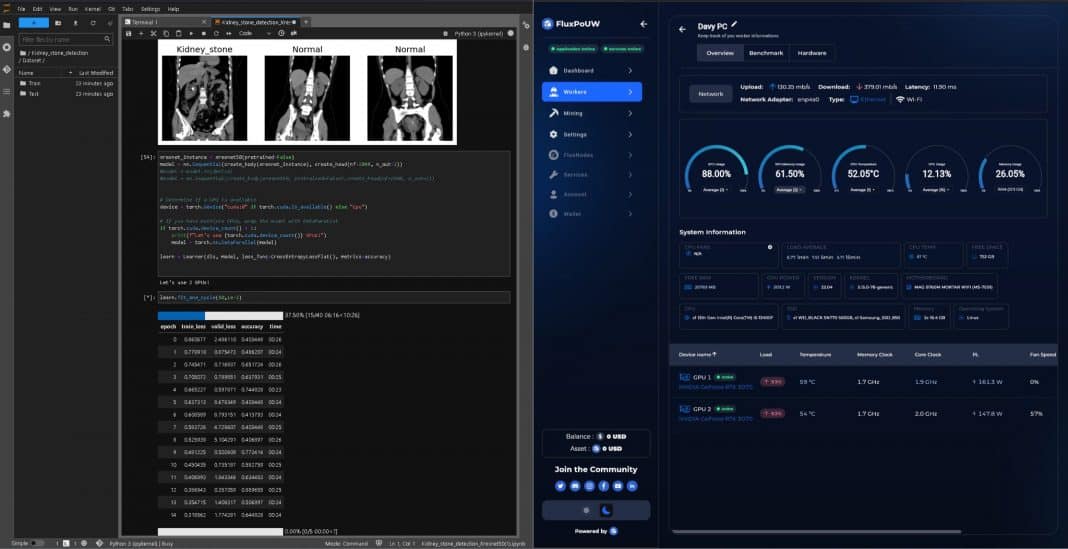In the era of technological advancements, the fusion of cutting-edge concepts often births unprecedented innovations. One such thrilling amalgamation has recently emerged from the marriage of medical AI research and PoUW (Proof of Useful Work). The results? A more efficient and precise method for analyzing CT scans to detect kidney stones.
The Evolution of Medical Imaging AI
Over the years, medical imaging, especially Computed Tomography (CT) scans, has benefited significantly from the application of artificial intelligence. The main goal? To enhance the accuracy of diagnosis, reduce human error, and streamline the medical diagnostic process.
The traditional way of training AI in this domain involves feeding the system with numerous labeled images – some indicating the presence of kidney stones and others without. As the AI system processes more and more data, it learns to differentiate and pinpoint the telltale signs of kidney stones in CT scans with astonishing accuracy. This methodology has allowed radiologists and medical practitioners to expedite diagnoses and initiate treatment faster.
Enter PoUW: A Game-Changer for AI Research
Proof of Useful Work (PoUW) is a pioneering concept that ensures computational efforts in blockchain are channeled towards meaningful and beneficial work. Unlike the traditional Proof of Work (PoW), which often wastes computational resources in solving complex problems, PoUW strives to make every computation count.
The integration of PoUW in medical AI research means that the extensive computational power dedicated to validating blockchain transactions can now be harnessed for a noble cause: improving medical diagnostics.
Harnessing the Power of GitHub and Jupyter Notebook
The beauty of the present technological era lies in the vast availability and sharing of resources. An existing GitHub build designed for medical AI research was seamlessly integrated into this initiative. By running the build on a Jupyter notebook, researchers could effortlessly train their AI models. The simplicity of the Jupyter notebook, combined with the robustness of the GitHub build, allowed for a smooth workflow, eliminating the need for developing complex systems from scratch.
When this build was executed, the involved cluster smartly assigned it to the appropriate stack, thus ensuring optimal resource allocation and efficient processing.
Flux: The Future of Cloud Computing
Another integral component of this innovation is Flux ($Flux). In the ever-evolving landscape of Web3 and decentralized platforms, Flux stands out as a powerhouse in cloud computing. By leveraging the potential of Web3 technology, Flux offers decentralized computational solutions that are not only efficient but also democratize access to resources.
The use of Flux in this project epitomizes how Web3 and cloud computing can reshape the realms of medical research and AI. With decentralized platforms like Flux, the boundaries of what’s possible expand, granting researchers unprecedented access to computational power and resources.
Implications and The Road Ahead
This blend of medical AI research, PoUW, and the utilization of platforms like GitHub, Jupyter Notebook, and Flux, showcases the tremendous potential in cross-disciplinary collaborations:
- Accelerated Research: Using platforms like Jupyter and tapping into the power of Flux can significantly expedite research, allowing for faster iterations and real-time testing.
- Resource Optimization: With PoUW, wasted computational efforts are now a thing of the past. Every computation directly contributes to meaningful outcomes.
- Democratization of AI: With decentralized platforms and shared resources, smaller institutions or individual researchers can now access top-tier computational capabilities, leveling the playing field.
As we stand at the cusp of this revolutionary integration, it’s exhilarating to ponder the possibilities. Today, it’s kidney stone detection; tomorrow, it could be any other critical medical condition. By intertwining advanced technological paradigms with medical research, we’re not just pushing the boundaries of what AI can achieve but also ushering in a new era of medical innovation for the betterment of humanity.
Learn More about Flux
- Website – https://runonflux.io/
- Twitter – https://twitter.com/RunOnFlux
- Discord – https://discord.gg/runonflux
Thanks for reading and if you want to keep up with all things Web 3 follow us on twitter.


